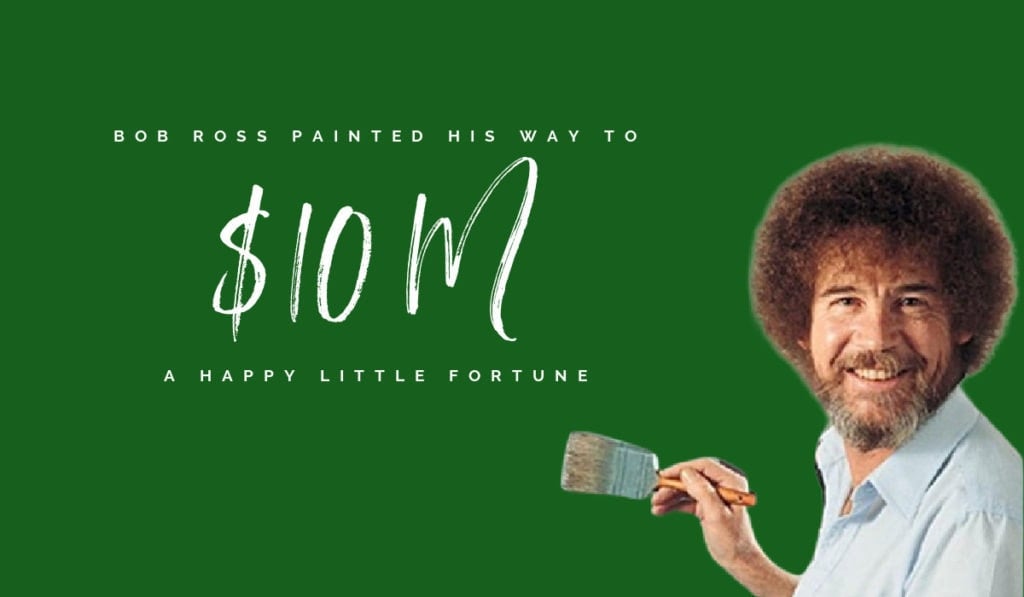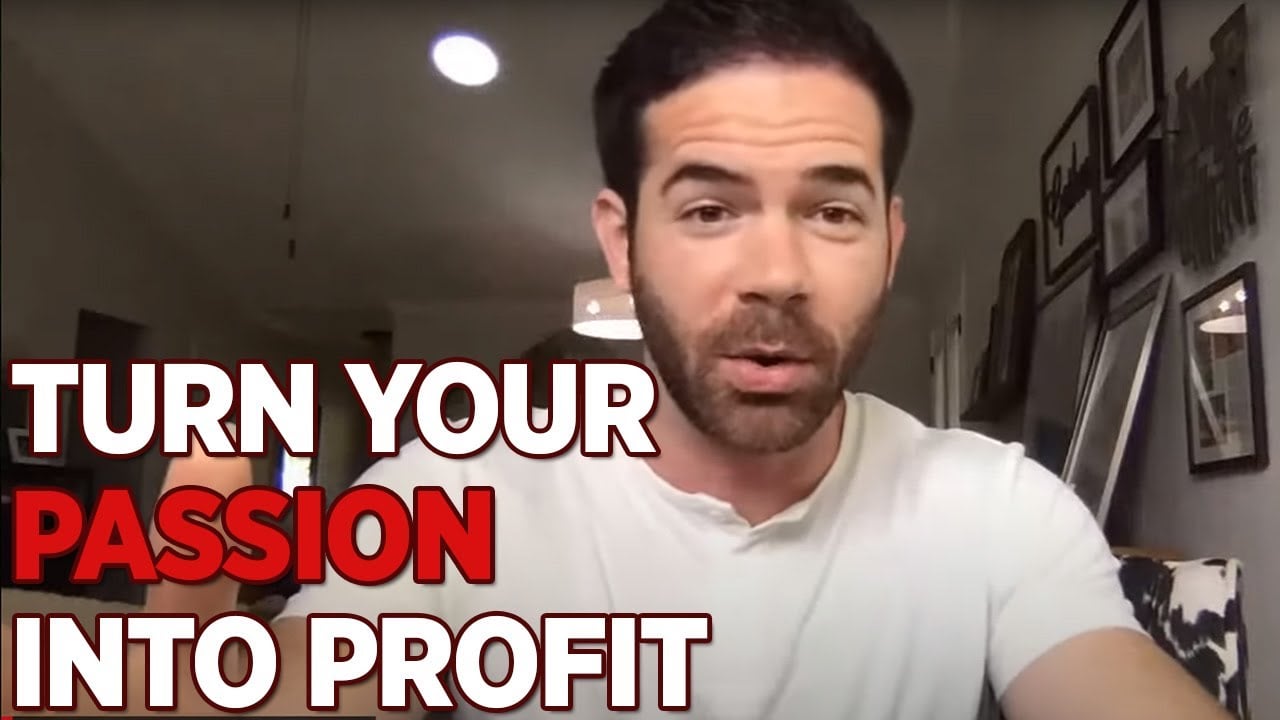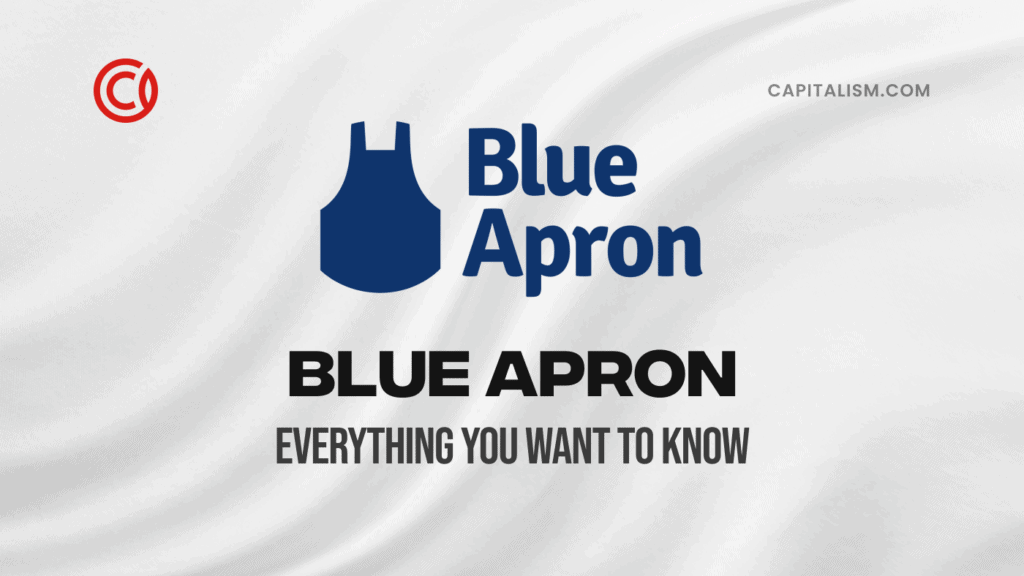The Joy of Capitalism: How Bob Ross Painted His Way to a Happy, Little $10M Fortune
26 minutes. That's the length of a single The Joy of Painting episode, and it was all the time Bob Ross needed to transform a blank canvas into an idyllic landscape. More importantly, he told viewers they could do it, too.
Fast forward 31 seasons and more than 1,000 on-air paintings later, Ross remains perhaps the best-known American artist. His pop icon status even landed his paintings in the world-renowned Smithsonian Museum years after his death.
Just how much can an untrained artist with a low-budget PBS show earn? By 1995, Bob Ross net worth was $10 million. And all he did was share his joy of painting with the world.
"The secret to doing anything is believing that you can do it. Anything that you believe you can do strong enough, you can do. Anything. As long as you believe."
Bob Ross
Here’s how you can turn your part-time hobby into a full-time income.
From “Sir, Yes, Sir!” to Happy Little Trees
Robert Norman Ross entered the world on October 29, 1942. He had a pretty typical upbringing. His parents, Jack and Ollie, worked blue-collar jobs as a carpenter and a waitress, respectively. Bob admired his parents, and he went on to say that he had the best mother in the world.
Soon after Ross entered his teenage years, he dropped out of high school. He shadowed his father and learned the art of carpentry. An on-the-job accident severed the top of his left index finger, which he often tried to hide later in life. (Watch how he holds the palette!)
Once Bob Ross turned 18, he enlisted in the United States Air Force. While stationed in Alaska, he attended an art class at the Anchorage USO club and discovered a passion for painting. At the time, Ross didn't realize this class would change his life's calling completely.
Ross eventually rose to the rank of master sergeant, where he found himself yelling at people constantly. After 20 years of service, he retired from the Air Force to pursue something different. He also pledged never to raise his voice again—and he kept that promise until his death.
In the early 1980s, Bob Ross found work as a bartender. During a shift, he discovered The Magic of Oil Painting, a PBS show hosted by Bill Alexander. The series enthralled Ross. He started mimicking Alexander's painting style and techniques to perfect his own craft.
Making Critical Connections
Ross's first paintings featured the beautiful landscapes he saw while stationed in Anchorage. He was able to sell a handful of his early paintings, earning a modest $5,000. It wasn't enough to pay the bills, but Ross knew he wanted to paint for a living. He started working for Alexander, both as a salesman and an art tutor.
While running a Bill Alexander painting workshop in Florida, Ross met Annette and Walt Kowalski. His painting style and teaching methods mesmerized the couple. Meeting them changed everything. They urged him to leave Alexander and start a company with them. He agreed to do it.
You are only one connection away from building an outrageously successful brand. Here’s a quick roadmap for making this kind of meaningful connection.
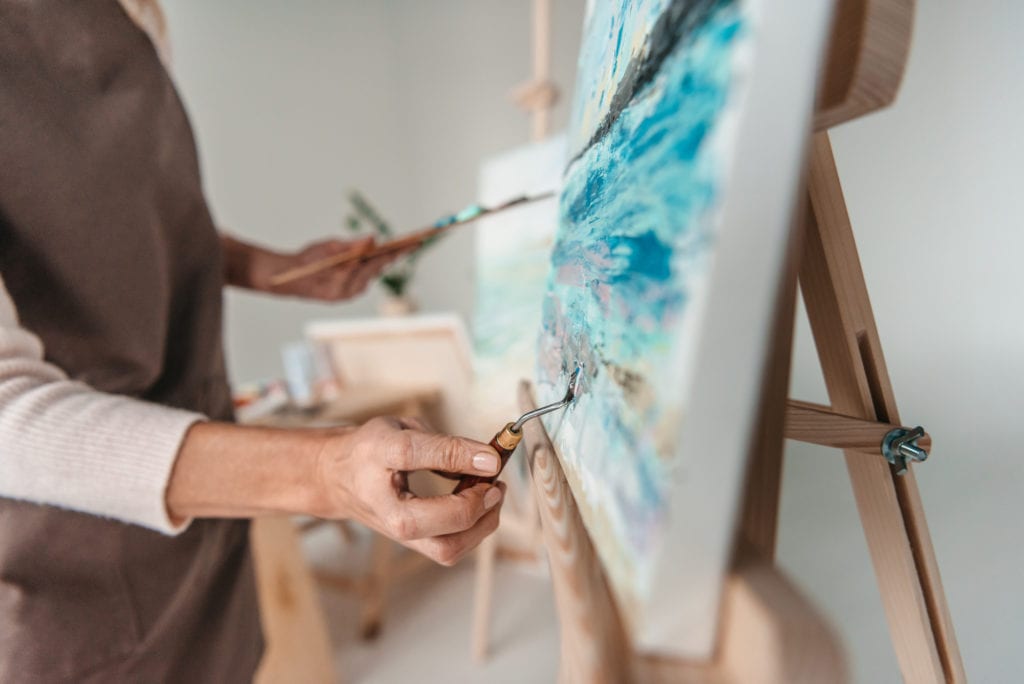
Annette and Walt helped create the Bob Ross we all know and love today. They advertised his painting classes in local newspapers and hosted public demonstrations. In January 1983, Annette landed a deal with a public broadcasting station in Virginia to record 13 episodes of The Joy of Painting. Everything happened at the speed of light, and the first episode aired on January 11, less than two weeks later. The gig didn't earn Bob any money, but it did help him gain exposure and build an audience.
Recording eventually moved to a studio in Indiana, where Ross painted in front of a solid black backdrop. Other stations—over 300, to be more precise—caught wind of the show and added The Joy of Painting to their lineup. Viewers couldn't get enough of Ross's calm demeanor, casual blue jeans, and poofy perm while he painted happy, little trees. By the end of the 80s, a staggering 80 million viewers tuned in to watch the show each week. And Bob Ross received 200 letters from rabid fans in the mail every day.
Painting Your Own Success Story Using the Bob Ross Method
Bob Ross's success may seem like a fluke—he just happened to be in the right place and meet the right people at the right time. But there is much more to it. While luck did play a role, his dedication to perfecting his craft and serving his audience is what ultimately built his $10 million fortune. Here's how you can follow in his creative footsteps:
Pursue Your Passions
Painting wasn't just a job for Ross—it was his true passion in life. He didn't realize this until much later in life, but even time didn't stop him from pursuing his dreams. Sure, he could have accepted a job anywhere and made a decent living, but he wouldn't have built an artistic empire.
As an entrepreneur, it's essential to be passionate about the path you follow. Jumping into an industry you don't care to learn about isn't a wise move. While you might make some money initially, you'll ultimately burn yourself out sooner than you hoped. Instead, look for a niche you can talk about for hours on end without growing bored—one that excites you every single day. And shout about it from the rooftops.
Passion produces positive, contagious energy, and when others sense your excitement, they are more likely to buy your product or service, no matter what you have to sell.
Be Authentic
Close your eyes and imagine Bob Ross. What do you see? Most likely, you envision a soft-spoken man with a wild, permed hairdo. Perhaps you can hear his gentle voice guiding you through the next brushstroke. Maybe you remember his halfway-unbuttoned chambray shirt and casual jeans. Ross was just an average man—that was his authentic self. And it quickly became his trademark.

Brand authenticity is crucial, but it's something too many entrepreneurs overlook. Instead of being genuine, transparent, and vulnerable, many brand owners try to wear Superman capes at all times. But even Superman was sometimes just Clark Kent—a white-collar worker with real feelings.
Want your business to grow and succeed? Remain open and honest with your audience at all times. If a launch doesn't go as planned or there are shipping delays, let them know. Your audience will most likely accept your flaws at face value and feel more connected to your brand.
Authenticity is at the core of every successful brand. It's tiring to pretend to be someone you're not, and others will see through your disguise. Imposters always get caught.
Dare to Be Different
Bob Ross could turn a blank canvas into an expressive landscape in just 26 minutes. And he did it using techniques often frowned upon by other artists of his time. Ross didn't follow the "traditional" rules of art. Instead of letting each coat of paint dry before applying the next, he opted for the wet-on-wet method. He also painted without overanalyzing every stroke. Unconventional? Yes, but this unique approach is what made The Joy of Painting so vastly popular with the average, non-artistic viewer.
While appearing on The Phil Donahue Show, the host told Ross his works would never hang in a museum. In rebuttal, Ross stated, "It's not traditional art. It's not fine art. And I don't try to tell anybody it is." And today, ironically enough, a handful of his paintings hang at several galleries, including The Smithsonian Museum.
Going against the grain isn't always the smoothest road to take, but it's often the most rewarding. Entrepreneurs who don't follow the status quo stand out from their counterparts. They are more likely to develop innovative solutions and create products their audience actually wants and needs. Being different is an excellent trait to possess.
Treat Your Audience Like Gold
Bob Ross never put himself on a pedestal. Instead, he made every single viewer feel like an equal—as if they all shared his innate talents. And while their finished artwork may not look as refined as his, Ross made everyone feel proud and accomplished. As he always said, "We don't make mistakes; we just have happy accidents."
Bob Ross made himself virtually accessible to his millions of fans. He always invited viewers to paint with him at the start of each show. And it's the reason so many people—especially Millennials—continue to watch reruns to this day.

Those who painted alongside Ross, whether at home or during in-person workshops, never felt excluded. As Krista Svalbonas, a photography professor at St. Joseph's University, explained to Artsy, "He really empowered his viewers. I made horrible Bob Ross paintings, but he did really make me feel like anything was possible."
As an entrepreneur, it is vital to make yourself accessible to your audience, no matter your niche. Ask them for suggestions, and be there to answer questions. Let your audience help guide you towards the next step of your journey. Even as your brand grows into a 7- or 8-figure business, it's crucial to remain connected to those who made it all possible.
Death of an Artist
On July 4, 1995, Ross passed away from lymphoma. He was only 52. Ross worked up until his last breath, and many people didn't even know he was sick. Instead, he wore a wig to conceal his chemo-induced baldness and remained upbeat until the end.
But Ross's passing wouldn't put a damper on his paintings or show. It's been more than 25 years since his death, but The Joy of Painting remains in syndication today, thanks to the magic of reruns and a cult-like following.
COVID-19 introduced an entirely new audience to Bob Ross in 2020. As the pandemic slowed the world to a grinding halt, more people streamed episodes than ever before. Why? Ross's calming, ASMR-esque voice offered them peace and tranquility during an otherwise tumultuous time. And he always encouraged everyone, "You have unlimited power on this canvas. You can literally, literally move mountains."

Fun Facts About Bob Ross Art
Even as his popularity soared, Bob Ross never let ego get into his way. Instead, he remained humble and true to himself. As a result, his works remain in high demand by art collectors across the world. Want to own a happy, little piece of history? Here's what you need to know first:
Who owns the Bob Ross company?
Joan Kowalski, the daughter of Annette and Walt, is the current president of Bob Ross, Inc.
Where is Bob Ross Incorporated?
You can find Bob Ross, Inc in Herndon, VA. The company phone number is 1-800-BOB-ROSS. Joan reports she still receives numerous calls each day from devoted fans.
How many Bob Ross paintings exist?
No one knows the exact number of paintings out there, but there were at least three copies of each painting for every episode produced. Since Ross painted in 381 episodes, at least 1,143 exist. But that number doesn't include works he created for public events or charity. Some estimated he painted tens of thousands of canvases.
How much is a Bob Ross original?
Good luck finding a Bob Ross original painting; they rarely come up for sale or auction. But when they do, they sell for a hefty price. In recent years, authentic paintings sold for $8,000 to $10,000! However, be suspicious of anyone claiming to sell a "genuine" original—tons of counterfeits exist. Every original should come with a certificate of authenticity.
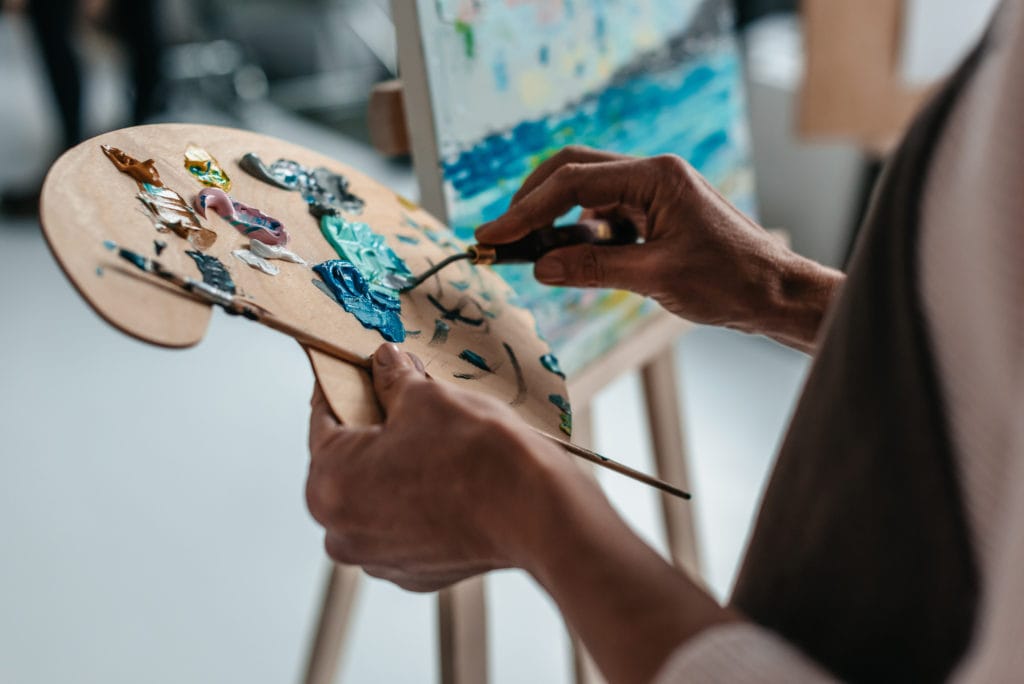
Can you buy Bob Ross original paintings?
Finding Bob Ross paintings for sale is like finding a needle in a haystack—perhaps even harder. Although countless works exist, no one wants to sell. Joan Kowalski says they have 1,165 paintings at the headquarters, and a few remain on display at museums across the country.
Why can't you buy a Bob Ross painting?
If you can find one for sale, you are more than welcome to purchase it. However, most of the charities and museums Bob Ross donated to have no intention of ever selling their prized possessions. But as his works grow more valuable, some private owners may sell to the highest bidder.
Who is Bob Ross' son?
Ross had only one child with his first wife, a son named Robert Stephen Ross. Steve, as he goes by, inherited his father's artistic abilities. He even appeared on The Joy of Painting for several episodes. In 2020, Steve held painting workshops across the United States and taught students his dad's wet-on-wet painting method.
How can I paint like Bob Ross?
Ross loved sharing his joy of painting with others. And those who became Bob Ross Certified Instructors also passed the torch to future generations of artists. If you want to learn his methods at home, you can buy a Bob Ross painting kit here.
It's Time to Pass the Brush
While there will never be another Bob Ross, there is still room for other passionate entrepreneurs to build their legacies. Now is the time to follow your dreams, create a brand that solves problems, and serves others. We'll root for you during every step! And as Ross famously said, "You might even make something beautiful."
